Steam Deck OLED review: The ultimate handheld
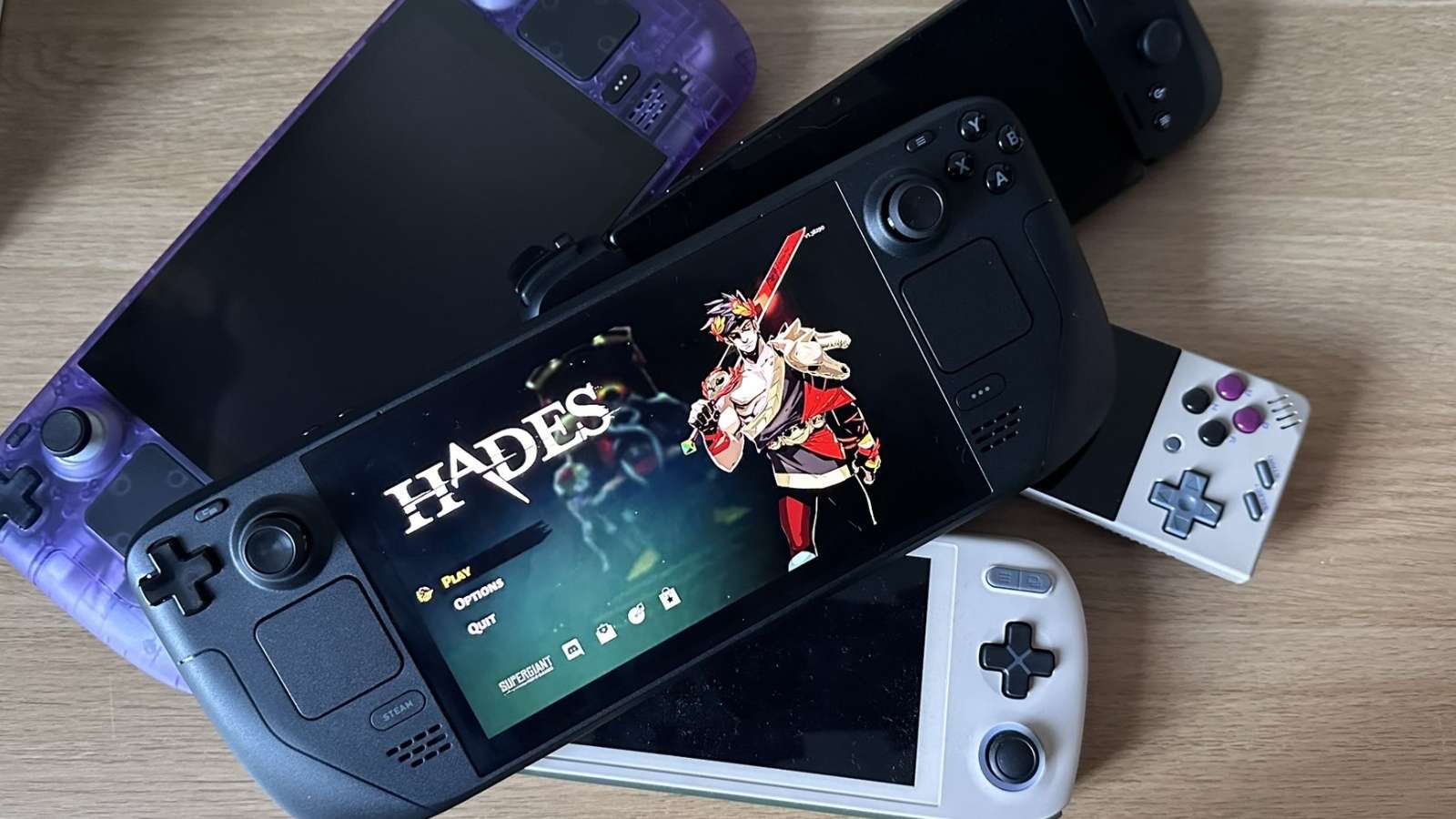 Dexerto
Dexerto Valve’s Steam Deck OLED was released with much fanfare, and after hours of testing one, I’ve finally been able to gather my thoughts on Valve’s latest portable powerhouse, and how it compares to the competition.
It’s been over two years since the Steam Deck was initially revealed. Little did we know that handhelds from the likes of Ayaneo would inspire Valve to make its own handheld in partnership with AMD. Now, years later, the market is littered with powerful handhelds of all shapes and sizes. But, the original Steam Deck is by far the most popular amongst the current handheld crop.
So, when Valve unleashed the updated Steam Deck OLED onto the world, I was surprised at just how many changes the company has made to the original hardware. Dexerto reviewed the original Steam Deck last year, and I’ve used one of my own for several months, alongside a slew of devices from Ayaneo over the past year and change.
When the console landed, I honestly didn’t expect much. But, after spending tens of hours with the system, it’s immediately become my new go-to handheld console.
Key specs
| Specs | Details |
|---|---|
| APU | 16GB quad-channel LPDDR5 @ 6400MT/s |
| Process | 6nm |
| CPU architecture | AMD Zen 2 |
| CPU clock speed | 2.4 – 3.5GHz |
| Cores | Threads | 4 | 8 |
| GPU architecture | AMD RDNA 2 |
| GPU clock speed | 1 – 1.6GHz |
| Stream processors | 512 |
| RAM | 16GB quad channel LPDDR5 @ 6400MT/s |
| Storage | 512GB NVMe | 1TB NVMe (Reviewed) |
| Display | 7.4-inch OLED touchscreen |
| Native resolution | 1280 x 800 |
| Refresh rate | 40-90Hz |
| Audio | Stereo speakers, 3.5mm jack, dual mics |
| Connectivity | Wi-Fi 6e, Bluetooth, 1x USB Type-C with DisplayPort 1.4 support |
| Battery | 50Whr | 5,313mAh |
| Dimensions | 11.7 x 4.6 x 1.8-inch (298 x 117 x 49mm) |
| Weight | 1.41lbs (640g) |
Design
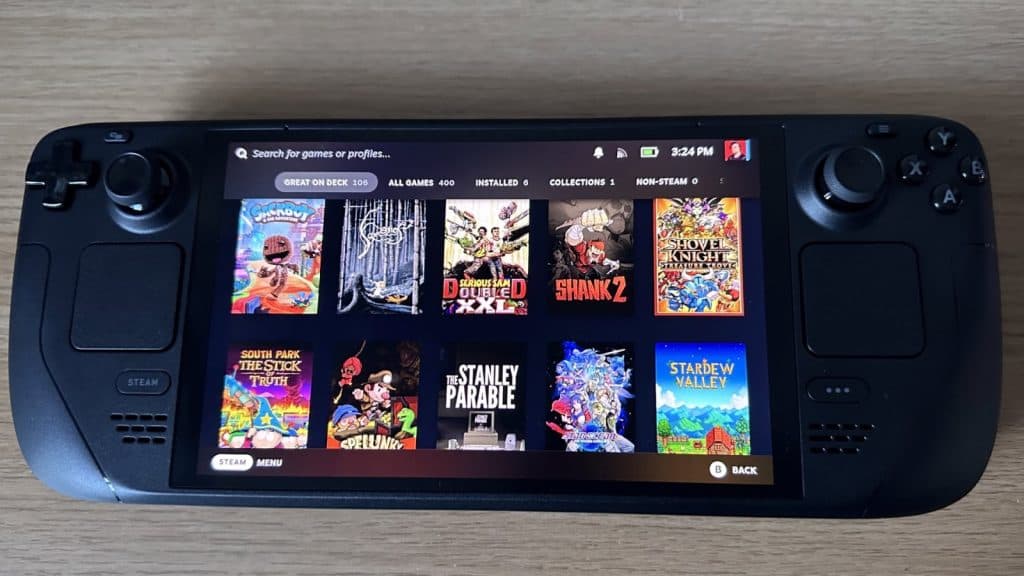 Dexerto
Dexerto On the surface, the Steam Deck OLED hasn’t actually changed too much when it comes to physical design. The system is clearly inspired by Nintendo’s excellent Wii U gamepad from a decade ago, with additional notes taken from the Steam Controller, alongside two pairs of rear buttons that you can assign to pretty much anything you want.
But, crucially, the new Deck OLED is a bit lighter than its predecessor, noticeably so. The main reason I always reach for the Ayaneo Air 1S is down to how light the system is to use, which is an itch the original Steam Deck never really scratched for me. Now 30g lighter, the Steam Deck OLED has somehow made it much easier to hold in my hands for long periods of time when playing games.
Other areas of improvement are in the analog sticks, and the trackpads, which feel significantly different from the original deck. Sadly, Valve has not chosen to use hall-effect sensing analog sticks for the Deck OLED, which is a popular modification, and also present on many other gaming handhelds.
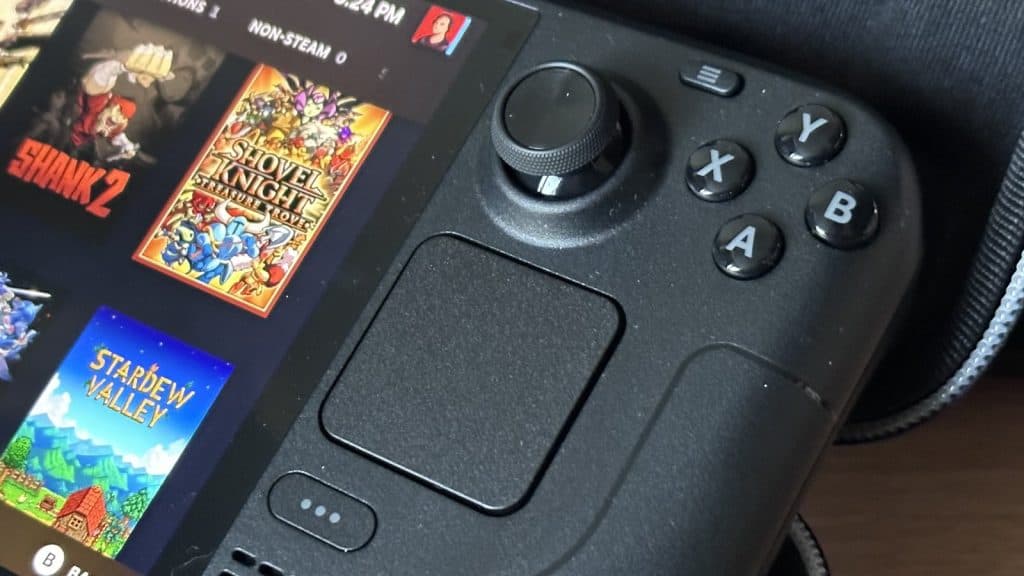 Dexerto
Dexerto But, the biggest change to the Steam Deck is in that gorgeous OLED screen.
Display
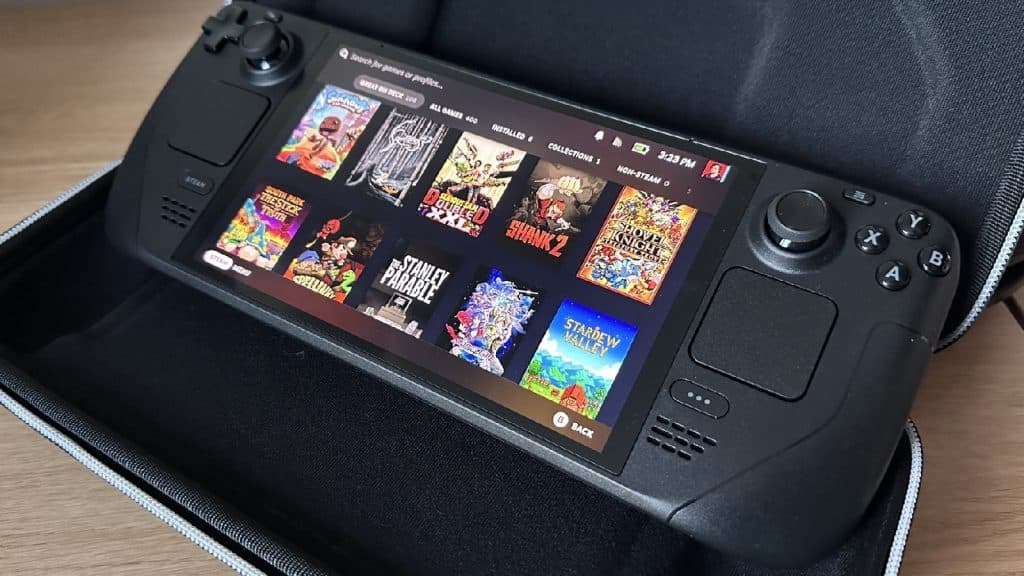 Dexerto
Dexerto Sporting a 7.4-inch OLED display, the system reduces the bulky bezels seen on the original Deck, which makes for a much better-looking device, and can now boost its refresh rate up to 90Hz (or up to 120Hz, if you’re feeling brave). But, unchanged is the resolution of the display, which sits at 1280×800. This never feels blurry while in use, but it definitely doesn’t have the sheer pixel density seen on other handhelds like the ROG Ally or Ayaneo 2S.
The benefit of the display is also that you’ll get up to 1000 nits of Peak brightness, which is noticeably pretty to look at, and might come in handy if you choose to take the Deck out and about with you for use in airports, on a train or in a park. It’s not the best display I’ve ever borne witness to, but it’s certainly a major step up in quality compared to the original model, especially with HDR support.
The touchscreen is also a bit more responsive, but in all honesty, I use it so little, that I have barely noticed the increase in polling rate. However, this subtle change makes a huge difference.
The Deck OLED ships with several different screens, confusingly. Our review unit uses a Samsung OLED display, which looks great in our eyes, despite its slight blue bias in its sub-pixel arrangement.
Upgraded antennas
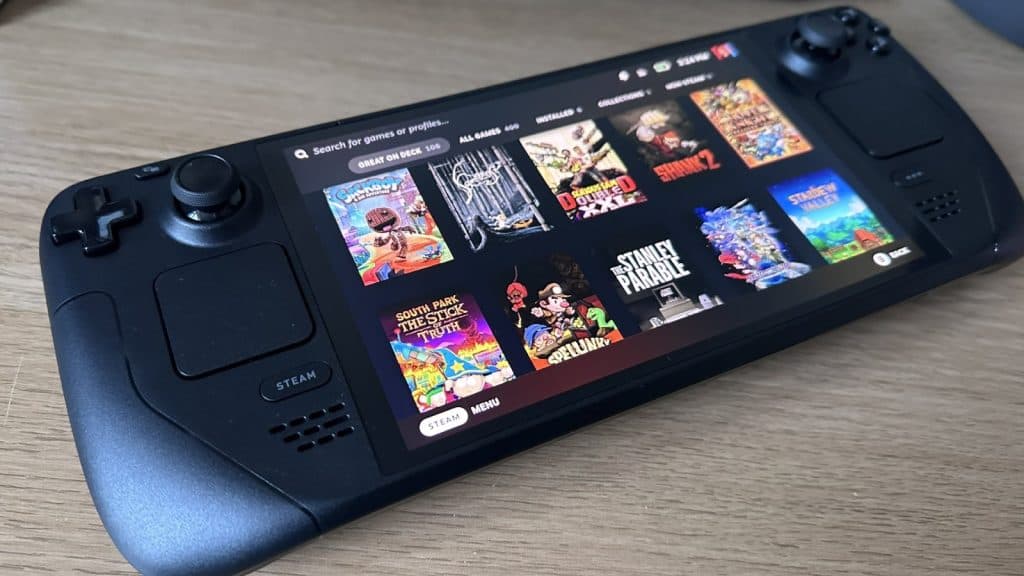 Dexerto
Dexerto The Steam Deck OLED now supports WiFi 6E, in addition to low-latency Bluetooth, which is really, really good. This speeds up the time it takes for me to transfer over games from my main PC onto the Deck itself, and when I timed transfers of Star Ocean 2: The Second Story from my PC to the Steam Deck OLED and original model, there was a noticeable speed increase which led to the game being transferred in 15 minutes, compared to around 30 on the original model. Of course, your mileage may vary when it comes to your own home internet connection.
Souped-up silicon
The Steam Deck OLED might not offer a direct power boost when compared to its direct predecessor, in fact, it all remains relatively unchanged, aside from being powered on a smaller node. But, you do get faster RAM in the system, which now boosts to 6400 MT/s, offering a marginal performance increase in some titles.
However, performance as a whole remains largely unchanged in my gaming tests, pushing the Deck to the brink in Cyberpunk 2077: Phantom Liberty and playing long sessions of Star Ocean 2: The Second Story still nets largely similar results to the older model. Those looking for a performance boost will need to look toward other devices like the Ayaneo Slide or Lenovo Legion Go, until we see a Steam Deck 2.
But, the 6nm Sephiroth APU that Valve has plopped into the Steam Deck OLED is one of the most crucial upgrades here, especially when it comes to battery life.
Boosted battery power
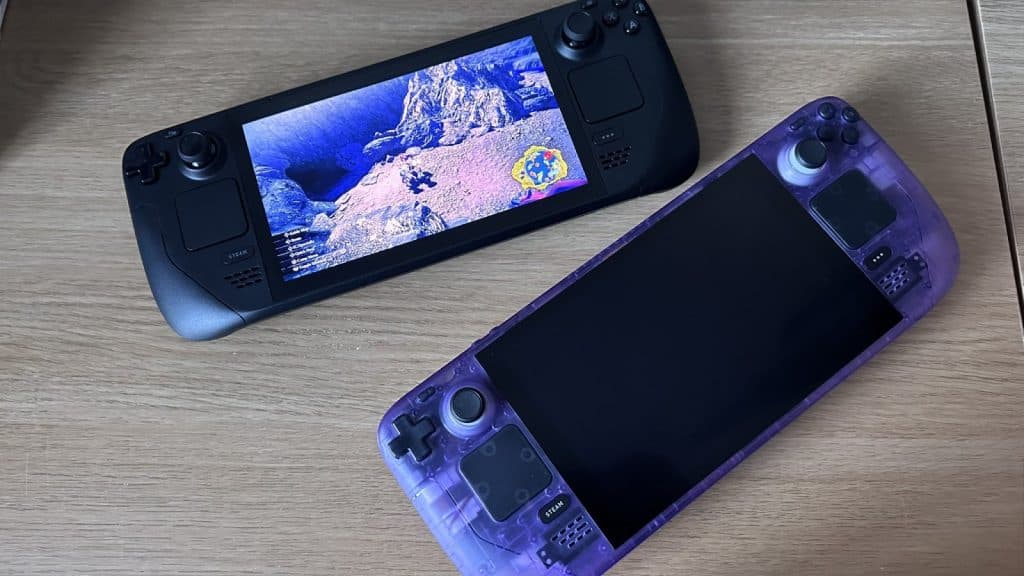 Dexerto
Dexerto The Steam Deck OLED has a boosted battery of 50WHr, making it one of the largest we have seen in a gaming handheld. Coupled with the efficiency changes of switching to an OLED display, alongside the node shrink make it one of the longest-lasting gaming handhelds outside of the Ayaneo Kun.
In my tests, the Steam Deck OLED can last over four hours, when testing the system using Star Ocean 2, at 60Hz. At 90Hz, the battery dips into three-hour territory. However, the LCD model comparatively managed under two hours of total gameplay. For games that utilize HDR, you should also expect a slight battery hit.
These improvements are astonishing, and they almost completely eliminated the usual battery anxiety I have while using powerful handheld devices. Faster charging also enables you to top-up the device with a bit of juice to almost 100% in just over an hour, which is utterly fantastic.
Performance & Software
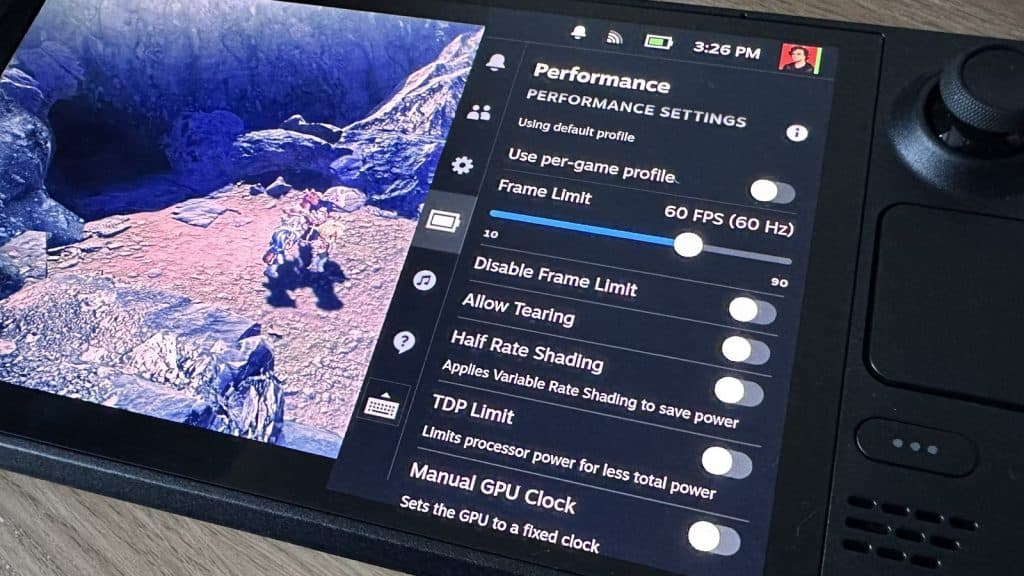 Dexerto
Dexerto The Steam Deck OLED’s performance might not match the latest and greatest Windows handhelds, but it does manage to bring a good amount of power in most modern AAA titles, such as Baldur’s Gate 3, which runs excellently on Steam Deck.
Powered by a custom AMD APU, the Steam Deck offers RDNA 2 graphics, which will manage to play most titles out there. However, certain current-generation titles, like Starfield, might struggle to run. With this in mind, Valve’s classification of playable, compatible, and verified games is a godsend. All you need to do is browse the Steam Store and look for the right little symbols.
It’s all devilishly simple, and it makes for an incredibly intuitive software experience. You can access in-game settings to change your refresh rate, in addition to brightness and much more in a small pop-up window. It’s much slicker than any Windows handheld out there, and it just works.
Killer pricing
The Steam Deck OLED starts at $549, making it competitive against the likes of the ROG Ally, Lenovo Legion Go, and Ayaneo’s legions of gaming handheld devices. It blows them all out of the water when it comes to the price, performance, and experience on offer. There’s just no substitute here.
Should you buy it?
If you already have a Steam Deck, then this is a great upgrade, if you find yourself turning to Valve’s portable console a lot. If you don’t have a Steam Deck yet and can swallow the extra cost, this thing is a no-brainer. It’s the most fully fleshed-out gaming handheld on the market. While it might not be the most powerful, it makes up for in efficiency and battery life.
The overall user experience is just head-and-shoulders higher than everything else out there. Since it also begins at 512GB of base storage, there’s ample space for all manner of games, too.
I’m struggling to find negatives here, but really the omission of hall-effect joysticks seems to be the only thing I can think of.
The verdict: 5/5
The Steam Deck OLED signals a maturation of both hardware and software to deliver a cohesive, industry-leading experience. Even when up against more powerful competition, the Steam Deck OLED has become my go-to gaming handheld.
Valve has come a long way since the era of Steam machines, and now I can’t wait to see what the company has cooking next.